Yesterday’s analysis was indecisive. The preferred Elliott wave count required downwards movement, but volume suggested this might not happen.
Price did move lower. The preferred Elliott wave count now looks right and on track.
Summary: Tomorrow should see another red daily candlestick or doji towards the target at 2,135. This target may be reached in one to three days time.
Last monthly chart for the main wave count is here.
New updates to this analysis are in bold.
MAIN WAVE COUNT
WEEKLY CHART
Cycle wave V must subdivide as a five wave structure. I have two wave counts for upwards movement of cycle wave V. This main wave count is presented first only because we should assume the trend remains the same until proven otherwise. Assume that downwards movement is a correction within the upwards trend, until proven it is not.
Primary wave 3 is shorter than primary wave 1, but shows stronger momentum and volume as a third wave normally does. Because primary wave 3 is shorter than primary wave 1 this will limit primary wave 5 to no longer than equality in length with primary wave 3, so that the core Elliott wave rule stating a third wave may not be the shortest is met. Primary wave 5 has a limit at 2,302.47.
Primary wave 2 was a shallow 0.40 expanded flat correction. Primary wave 4 may be exhibiting alternation as a more shallow combination.
Primary wave 4 may not move into primary wave 1 price territory below 2,111.05.
It is also possible to move the degree of labelling within cycle wave V all down one degree. It may be only primary wave 1 unfolding. The invalidation point for this idea is at 1,810.10. That chart will not be published at this time in order to keep the number of charts manageable. The probability that this upwards impulse is only primary wave 1 is even with the probability that it is cycle wave V in its entirety.
DAILY CHART
Primary wave 4 may be now complete as a double combination.
It is possible now that primary wave 4 could continue further as a triple, but because triples are very rare the probability of this is very low. If it is over here, then the proportion with primary wave 2 looks right. Within primary wave 5, no second wave correction may move beyond the start of its first wave below 2,119.12.
Primary wave 1 lasted 47 days, primary wave 2 was even in duration at 47 days, primary wave 3 lasted 16 days, and primary wave 4 has lasted 37 days. The proportions between these waves are acceptable.
If primary wave 5 has begun here, then at 2,233 it would reach 0.618 the length of primary wave 1.
At this stage, an impulse for primary wave 5 looks unlikely with invalidation of that idea at the hourly chart level. An ending diagonal now looks more likely for primary wave 5. Ending diagonals are choppy overlapping structures. The classic technical analysis equivalent is a rising wedge. They are terminal structures, doomed to full retracement at their end.
If primary wave 5 comes up to touch the upper edge of the maroon channel, it may end there.
HOURLY CHART
If primary wave 5 is subdividing as an ending diagonal, then all sub-waves must subdivide as zigzags. Intermediate wave (1) may be a completed zigzag.
Second and fourth waves within diagonals have a normal depth of from 0.66 to 0.81 the prior wave. This gives a target range for intermediate wave (2) from 2,140 to 2,131.
Intermediate wave (2) must subdivide as a zigzag. It may not move beyond the start of intermediate wave (1) below 2,119.12.
Intermediate wave (1) lasted a Fibonacci eight days.
Intermediate wave (2) may be just over half way through and has so far lasted five days. It may continue for another three if it is even in duration with intermediate wave (1) and exhibits a Fibonacci number of eight days. It does not have to take this long and may end more quickly now.
Intermediate wave (2) should be expected to be a big obvious three wave structure. So far minor wave B shows at the daily chart level as two green daily candlesticks. Minor wave C downwards now looks like it has begun with one strong red daily candlestick.
At 2,135 minor wave C would reach equality in length with minor wave A. This target is within the range of 2,140 – 2,131.
So far, within minor wave C, minute wave i may be coming to an end. This degree of labelling is chosen because it would allow minor wave C to continue for three more sessions. When minute wave i is a complete five wave impulse downwards, then minute wave ii upwards should unfold and may not move beyond the start of minute wave i above 2,172.67.
ALTERNATE WAVE COUNT
WEEKLY CHART
What if an impulse upwards is complete? The implications are important. If this is possible, then primary wave 1 within cycle wave V may be complete.
With downwards movement from the high of primary wave 1 now clearly a three and not a five, the possibility that cycle wave V and Super Cycle wave (V) are over has substantially reduced. This possibility would be eliminated if price can make a new all time high above 2,193.81.
If an impulse upwards is complete, then a second wave correction may be unfolding for primary wave 2. Expectations on how deep primary wave 2 is likely to be are now adjusted. It may be expected now to more likely only reach the 0.382 Fibonacci ratio about 2,038.
At this stage, it looks like price has found strong support at the lilac trend line.
Primary wave 2 may not move beyond the start of primary wave 1 below 1,810.10.
DAILY CHART
If an impulse upwards is complete, then how may it subdivide and are proportions good?
Intermediate wave (1) was an impulse lasting 47 days. Intermediate wave (2) was an expanded flat lasting 47 days. Intermediate wave (3) fits as an impulse lasting 16 days, and it is 2.04 points short of 0.618 the length of intermediate wave (1). So far this alternate wave count is identical to the main wave count (with the exception of the degree of labelling, but here it may also be moved up one degree).
Intermediate wave (4) may have been a running contracting triangle lasting 22 days and very shallow at only 0.0027 the depth of intermediate wave (3). At its end it effected only a 0.5 point retracement. There is perfect alternation between the deeper expanded flat of intermediate wave (2) and the very shallow triangle of intermediate wave (4). All subdivisions fit and the proportion is good.
Intermediate wave (5) would be very brief at only 18.29 points. Intermediate wave (5) is 1.43 points longer than 0.056 the length of intermediate wave (1).
At this stage, primary wave 2 now has a completed zigzag downwards that did not reach the 0.236 Fibonacci ratio. It is very unlikely for this wave count that primary wave 2 is over there; the correction is too brief and shallow. Upwards movement labelled intermediate wave (X) is so far less than 0.9 the length of the prior wave down labelled intermediate wave (W). The minimum for a flat correction has not been met. Primary wave 2 may continue lower as a double zigzag. A second zigzag in the double may be required to deepen the correction closer to the 0.382 Fibonacci ratio.
Intermediate wave (W) lasted a Fibonacci 13 sessions. Intermediate wave (X) has now lasted a Fibonacci eight sessions. If intermediate wave (Y) is equal in duration with intermediate wave (W), that would give the wave count a satisfying look.
Primary wave 2 may not move beyond the start of primary wave 1 below 1,810.10. A new low below this point would see the degree of labelling within cycle wave V moved up one degree. At that stage, a trend change at Super Cycle degree would be expected and a new bear market to span several years would be confirmed.
HOURLY CHART
This wave count now expects downwards movement for a Fibonacci 13 sessions overall most likely, to end about 2,038.
TECHNICAL ANALYSIS
WEEKLY CHART
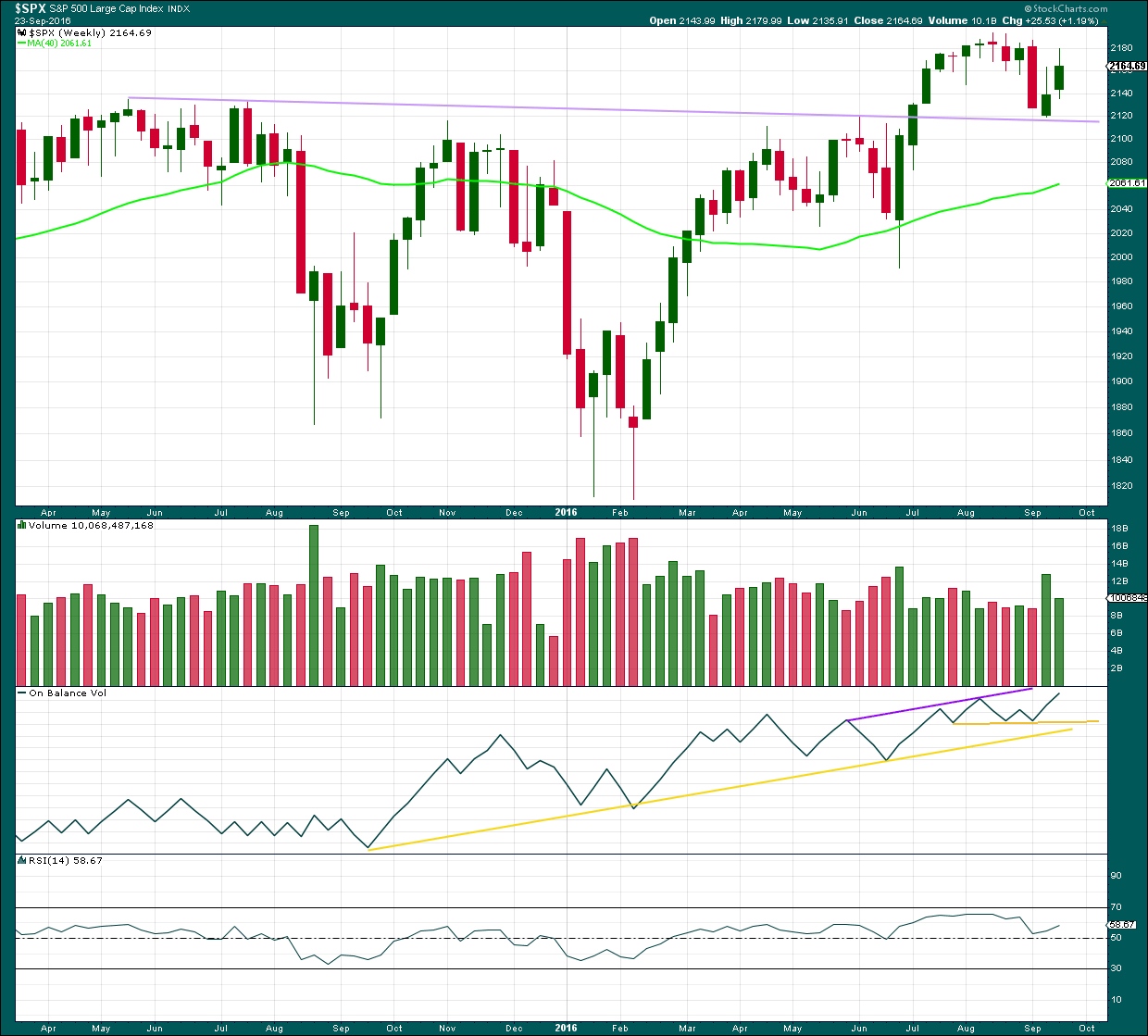
Click chart to enlarge. Chart courtesy of StockCharts.com.
The lilac trend line has provided very strong support whereas previously provided strong resistance. The strength of this line is reinforced. If price turns down from here, it should be again expected to provide support. A break below it would be a strong bearish signal.
Price broke above the long term lilac trend line in July 2016. The low two weeks ago almost perfectly found support at this line, and now price is moving up and away from the line. This looks like a typical breakout followed by a back test for support. It is a reasonable conclusion that price will move further up and away from this line. This view is in alignment with the main Elliott wave count.
On Balance Volume has made a new high above the high for the week of the 6th of August, but price has failed to make a corresponding new high. This divergence is bearish and indicates weakness in price. It does not say that price must turn down from here, only that price is weak. The bull market is unhealthy.
RSI is not extreme. There is room for price to rise further. There is no divergence between RSI and price at the weekly chart level to indicate weakness.
DAILY CHART
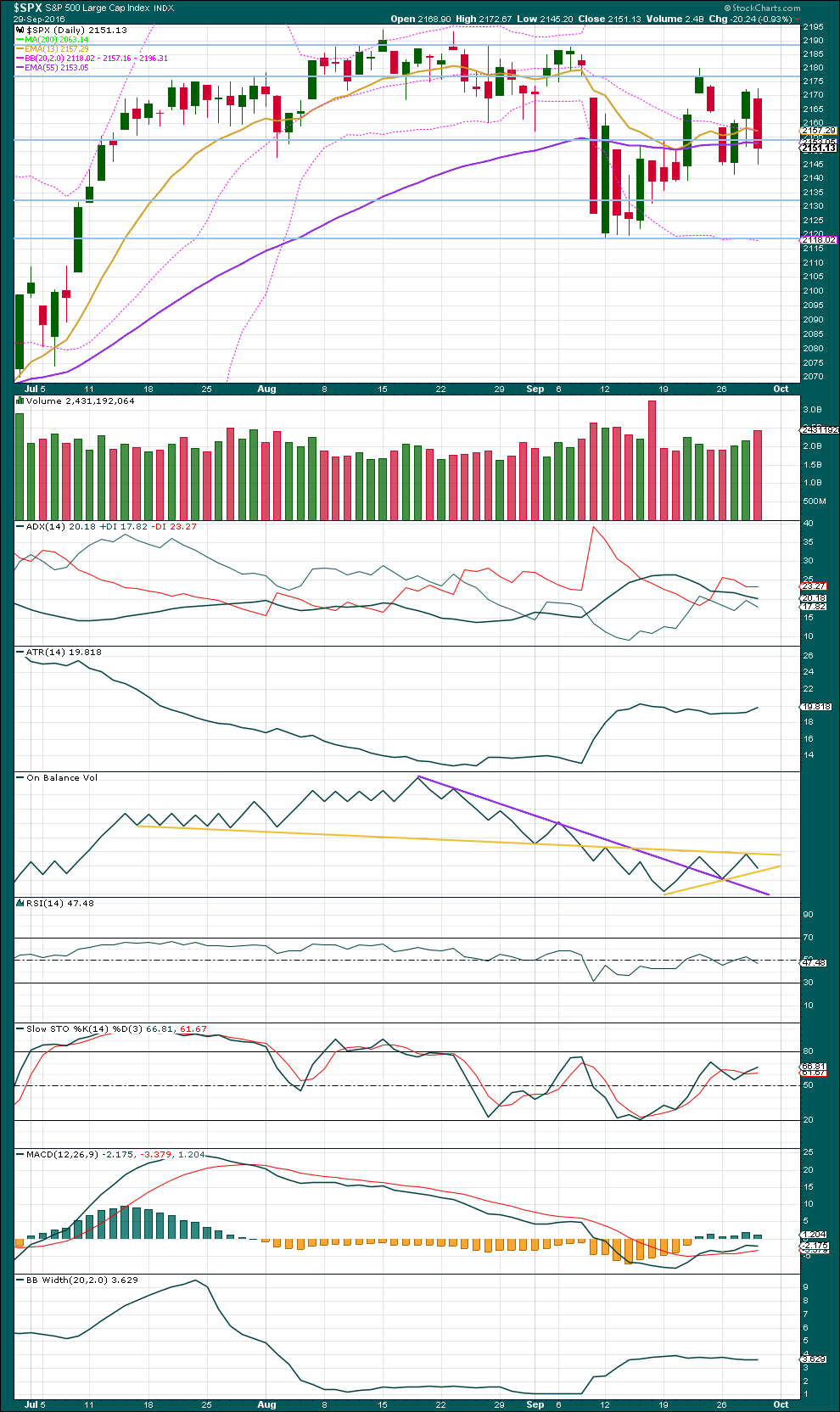
Click chart to enlarge. Chart courtesy of StockCharts.com.
A strong downwards day with an increase in volume is bearish today. The fall in price had support from volume for Thursday’s session, so more downwards movement for Friday at least would be a reasonable expectation. The next line of support for price is about 2,134, the prior all time high. This fits neatly with the target for the Elliott wave count. Following that, final support is at 2,120.
ADX is declining, indicating the market is not trending. ATR is overall flat, in agreement with ADX. Bollinger Bands are now very slightly contracting. This market is not trending. This market is consolidating.
Within this long consolidation, which began back on about 11th of July, it is three downwards days that have strongest volume. This suggests a downwards breakout is more likely than upwards. This trick may or may not work for the S&P at this time. It is one piece of evidence to weigh up. This consolidation is bounded by resistance at 2,190 and support at 2,120.
On Balance Volume has turned down from the long horizontal yellow resistance line. The strength of this line is reinforced. A new short support line is added today, in yellow, and this may provide a little support here. A break below the new yellow line would be a small bearish indicator. But this line is too short, sloped, and has only been tested once, so it does not have good technical significance. The purple line, which does have reasonable technical significance, should provide final support for OBV.
RSI is still close to neutral. There is plenty of room for price to rise or fall.
Stochastics has not yet reached overbought. Overall, a continuation of an upwards swing within this consolidation may be expected until price finds resistance and Stochastics reaches overbought at the same time.
There are three moving averages on this chart: a short term Fibonacci 13 days (gold), a mid term Fibonacci 55 days (purple), and a long term 200 days (lime). Both the mid and long term averages are still pointing up, and the mid term average is above the long term average. The longer term trend should be assumed to be up, until these averages prove it is not. The short term average has come down to kiss the mid term average and today it remains above the mid term average. The short term trend is fluctuating, exactly as expected within a consolidating market.
VOLATILITY – INVERTED VIX CHART
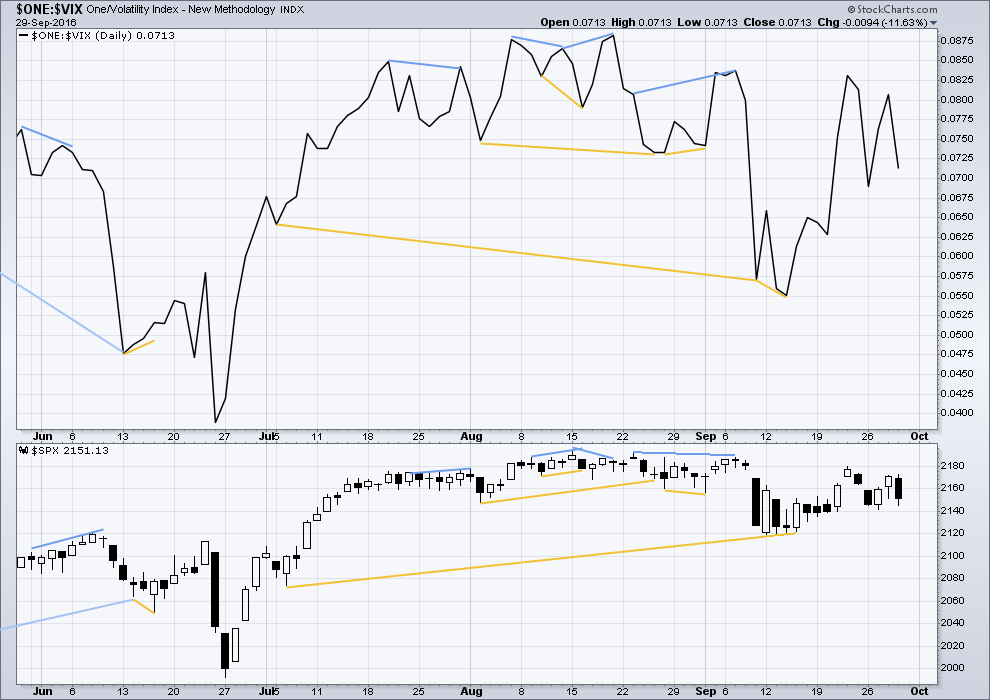
Click chart to enlarge. Chart courtesy of StockCharts.com.
There are a few instances of multi day divergence between price and inverted VIX noted here. Bearish divergence is blue. Bullish divergence is yellow. It appears so far that divergence between inverted VIX and price is again working to indicate short term movements spanning one or two days.
At this stage, no further short term divergence is noted between price and VIX to indicate any weakness either way.
BREADTH – AD LINE
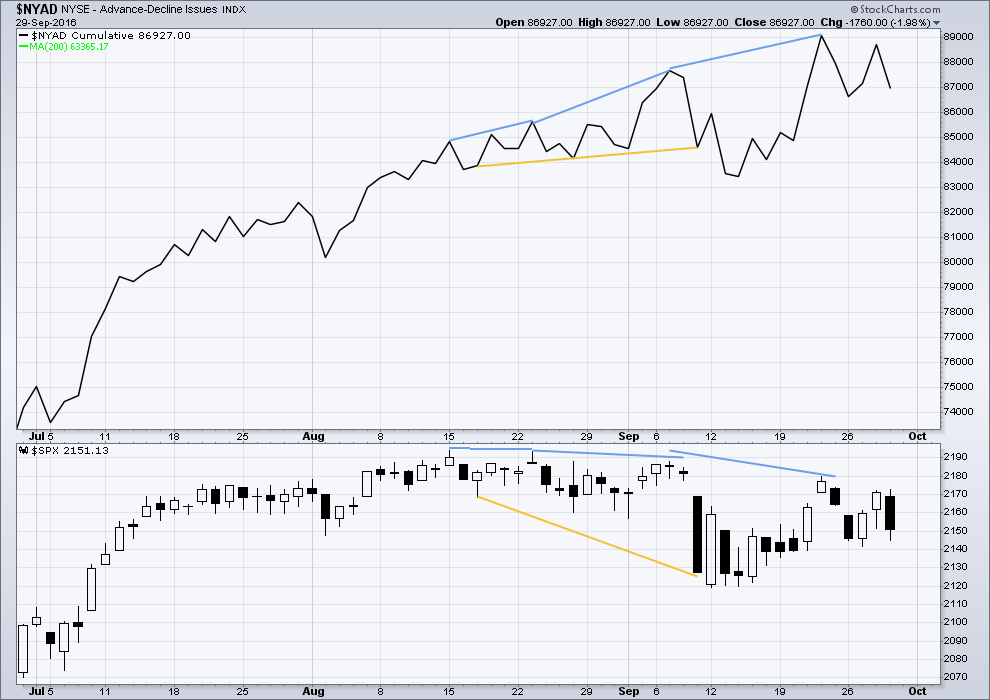
Click chart to enlarge. Chart courtesy of StockCharts.com.
There is support from market breadth as price is rising.
Short term bullish and bearish divergence is again working between price and the AD line to show the direction for the following one or two days.
No short term divergence between price and the AD line is noted today.
DOW THEORY
Major lows within the old bull market:
DJIA: 15,855.12 (15th October, 2014) – closed below on 25th August, 2015.
DJT: 7,700.49 (12th October, 2014) – closed below on 24th August, 2015.
S&P500: 1,821.61 (15th October, 2014) – has not closed below this point yet.
Nasdaq: 4,117.84 (15th October, 2014) – has not closed below this point yet.
Major highs within the bear market from November 2014:
DJIA: 17,977.85 (4th November, 2015) – closed above on 18th April, 2016.
DJT: 8,358.20 (20th November, 2015) – has not closed above this point yet.
S&P500: 2,116.48 (3rd November, 2015) – closed above this point on 8th June, 2016.
Nasdaq: 5,176.77 (2nd December, 2015) – closed above this point on 1st August, 2016.
Dow Theory Conclusion: Original Dow Theory still sees price in a bear market because the transportations have failed to confirm an end to that bear market. Modified Dow Theory (adding S&P and Nasdaq) has failed still to confirm an end to the old bull market, modified Dow Theory sees price still in a bull market.
This analysis is published @ 09:13 p.m. EST.
[Note: Analysis is public today for promotional purposes. Member comments and discussion will remain private.]

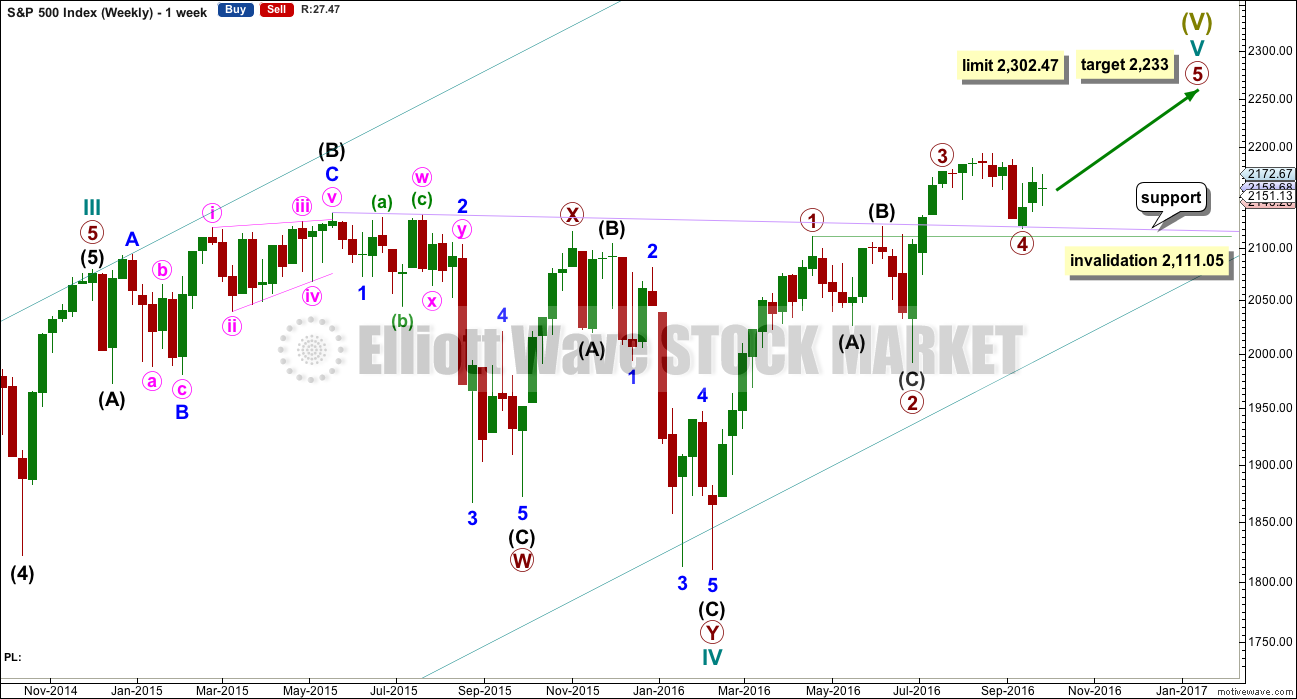
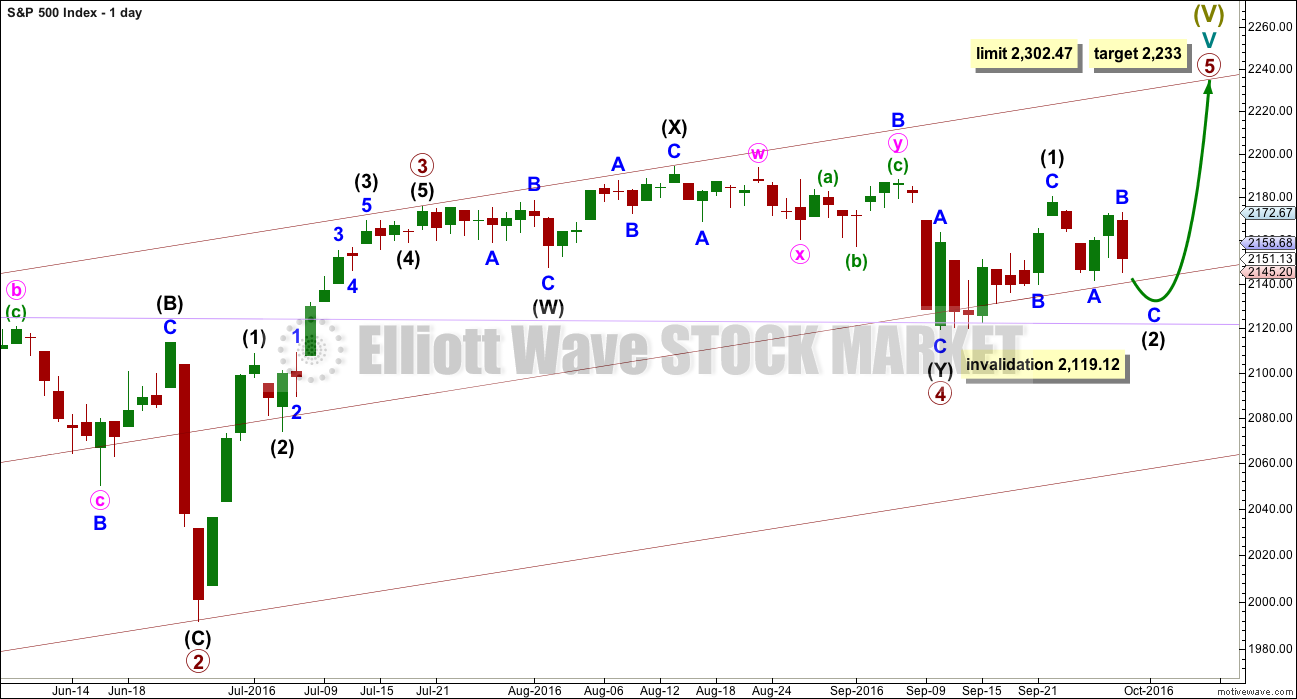
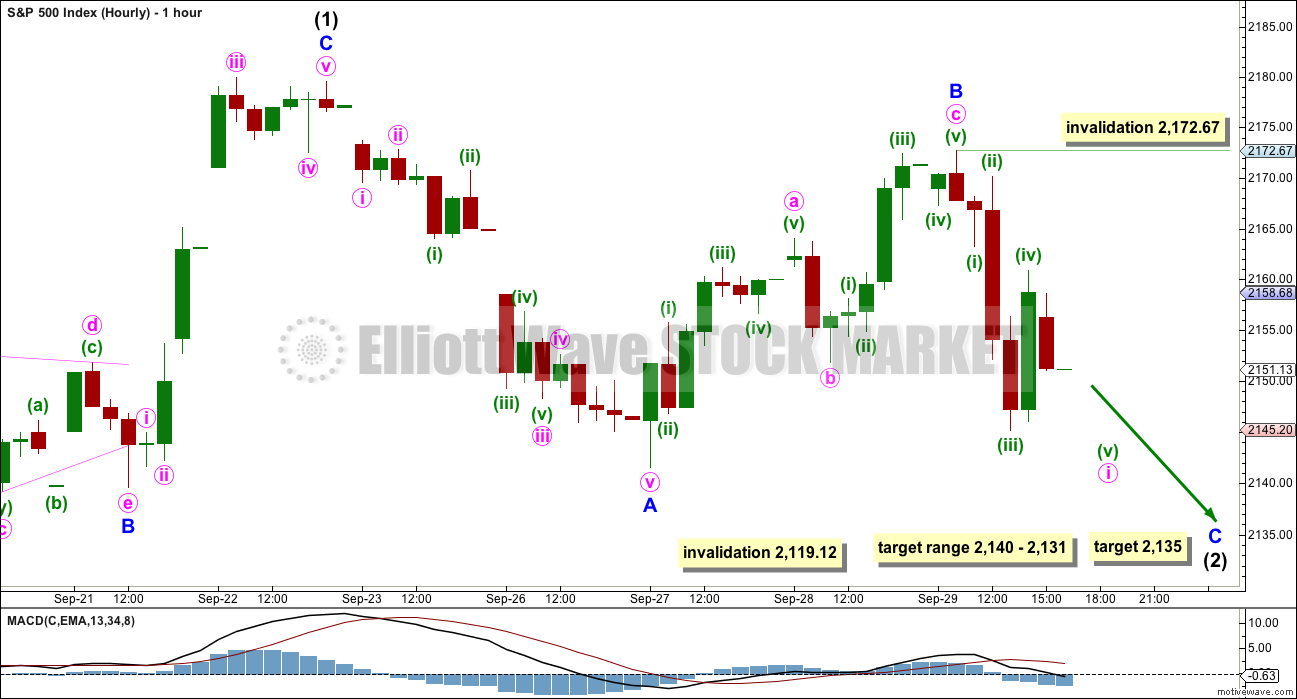
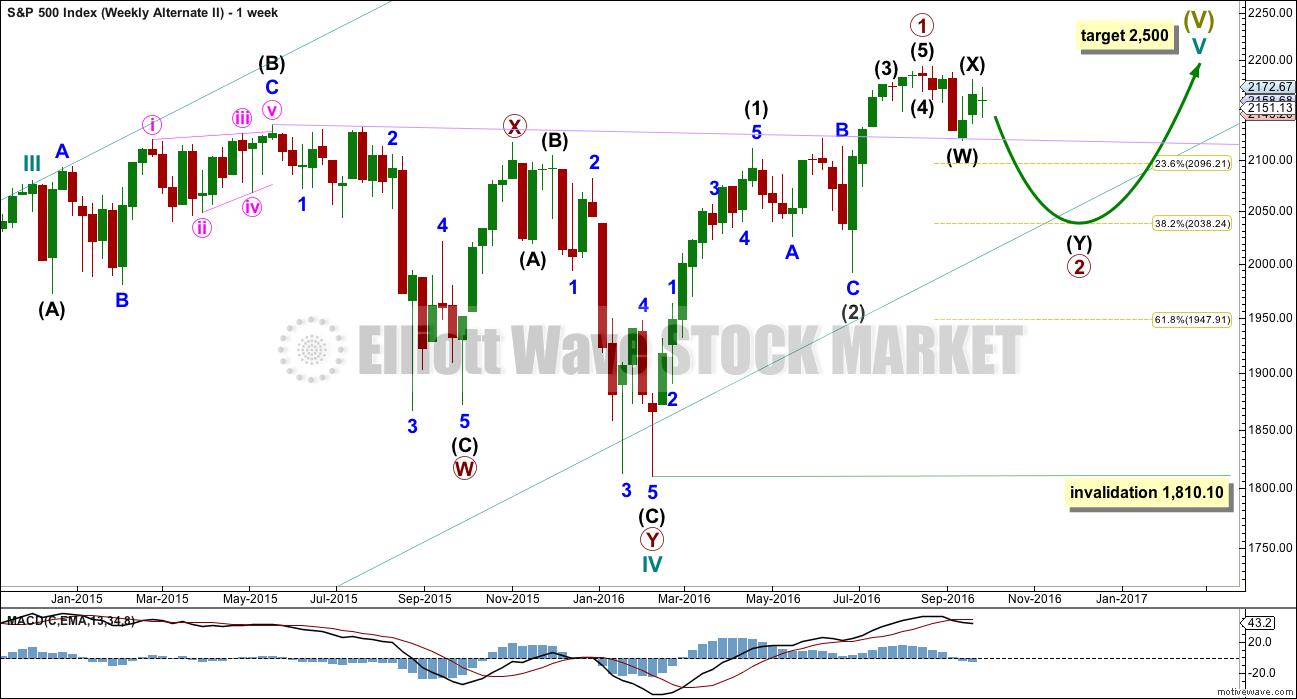
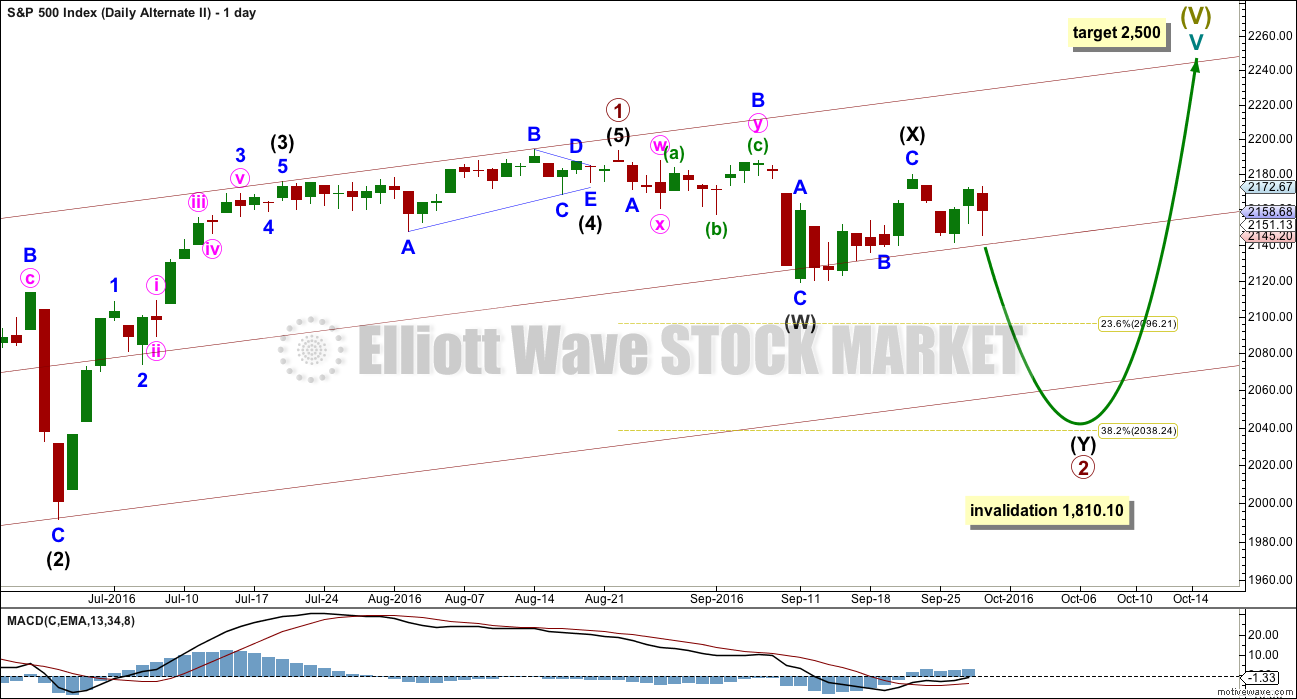
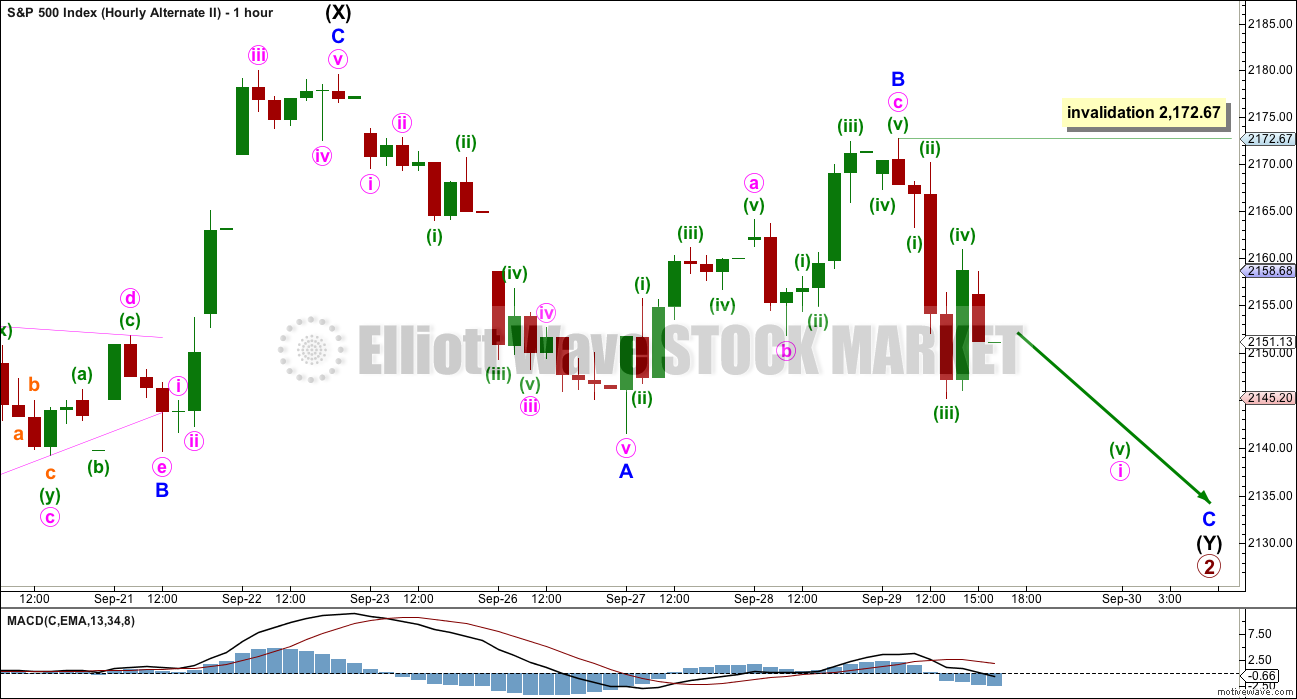
The last wave down didn’t complete as a five, it was a three. So minor B isn’t over folks.
This makes it a bit easier to see intermediate (2) continue for two more days now, to total a Fibonacci eight days / sessions.
Minor B isn’t a flat, the last three down is <0.9 of the prior three up. So it's more likely a double zigzag or double combination. A double combination would make more sense, it's overall a sideways move. A double zigzag is possible though.
I'll expect Monday and Tuesday next week to move price lower. That should complete intermediate (2).
Am I wrong or has the hourly been invalidated as 4 has come back into 1 territory?
You’re not wrong there 🙂
The last wave down was a three, it didn’t complete as a five.
Which means minor B wasn’t over. I was too quick to label it complete.
Price action in the markets the last seven plus years has been driven by the perception of central bank invincibility. The old notion of ” Don’t fight the Fed” even spawned a few new acronyms – BTFD (we all know what that means) and TINA, highlighting the fact that investors hungry for yields had no place to go but the stock market. We had the unprecedented matter of government bonds(and a few corporate) with negative yields on issue! JNK and HYG remain remarkably elevated, suggesting investor appetite for risk persists. Things may be about to change.
Long lower wicks and hammers have generally signaled banksters drawing a line in the sand. I learned the hard way not to ignore them regardless of what I thought the wave count was predicting, as they almost always reliably resulted in the arrest of market declines, and strong moves in the opposite direction. For anyone paying attention, this fact could not escape notice.
A trader may be right in his analysis, but too early in his execution. It does not help being ultimately right if you loose money by being too early. Someone commented on my surprise at the delay in the start of a run on DB. Are the hedge fund managers who finally took action yesterday really that stupid and or careless? Perhaps. I think their slowness to act has more to do with this perception of central bank prowess, despite what has happened to DB’s price over the past year. There are a lot of hedge fund managers who have already thrown in the towel because they refused to trade on the basis of central bank invincibility. They were right. But they were also early.
Two days ago DB put in a massive hammer and I concluded the banksters had gone to work. There is so little retail investor participation in the market that it is clearly central bank purchases that result in these long lower shadows imo.
Imagine my surprise when DB continued to tank the next day. It did bounce weakly but the low of that hammer has already been taken out and I expect DB to soon close below it. That was a game changer.
Despite a long lower wick in SPX on Wednesday, I sensed that there was something different in the air. Quite a few analysts are now seeing an ending diagonal in the markets and I think they are right. I bought DIA 185 puts going out a few weeks and you saw what happened yesterday.
The stage is now set for the blow-off top so many have been insisting should occur before a top is in. No doubt at the end of this current decline the banksters are going to go “all-in”, in a desperate attempt to show that they are still in control. A penetration of the 1-3 trendline of the ED will be your signal to settle your years-old scores with Mr Market.
Thank you Verne. A nice summary I think.
“A trader may be right in his analysis, but too early in his execution. It does not help being ultimately right if you loose money by being too early.”
I like this one. I’ve learned this the hard way too. Am still learning it. My response so far in terms of my own trading is to have more patience with the market. I hate day trading, so after my entry point I’ll just hold tight and keep my stop at the original place. This means my position may be underwater for days before coming positive, and if I have a loss it’s what I originally calculated was acceptable.
It is also my conclusion that my stops have to allow the market room to move. Setting them too close means I’m stopped out only to see price move in the expected direction. Setting them too close is usually the result of greed; it means I can have a larger position size so greater potential profit.
Managing greed is hard.
Back to the main bit of your comment, I’m watching DB closely. That is interesting re the hammer not signalling a turn.
It did the same thing on 27th of June though. A hammer, red, followed a few days later by a new low and no real upwards movement after the hammer.